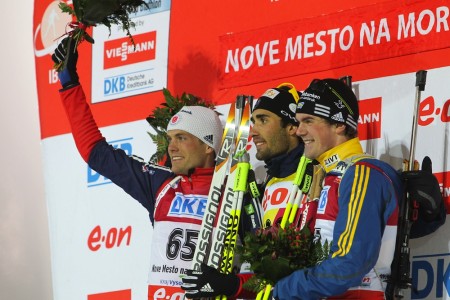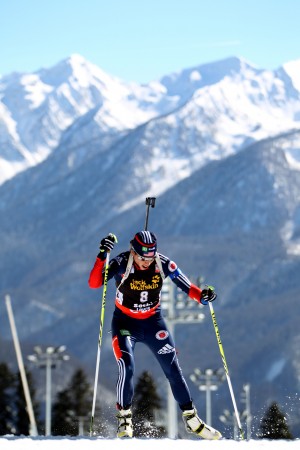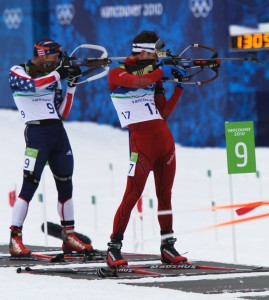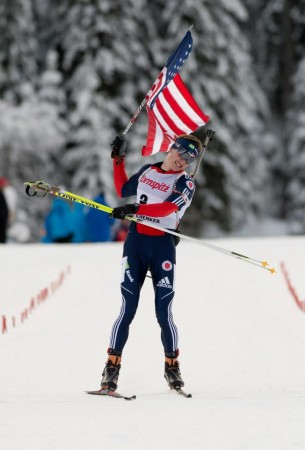
The last five years have seen the size, resources, and focus of the U.S. biathlon team rise and fall, then rise and fall again. There have been shifting standards on what constitutes an “A” team performance, how much discretion is used, the size of the “B” team, and even how late into the season athletes are added to the team.
But the 2014 season is different for one huge, glaring reason: Sochi, Russia, which will host the Olympic Games.
And so, in an effort to be the absolute best it can be at the Games, the U.S. Biathlon Association is sinking all of its resources into a skeleton crew of elite seniors as the big event draws near.
“That’s definitely what we’re doing, and what the [U.S.] Olympic Committee is willing to support,” USBA President Max Cobb told FasterSkier last week. “We will have a very different strategy for the 2014-15 season than we have now, that’s very clear… [but] that’s the approach we’re taking this year.”
Four men and four women were recently nominated to the “A” team for the 2013-2014 season, and just three athletes in total to the “B” team. It’s the smallest squad that the U.S. has nominated in years.
The group is headlined by Tim Burke, who won silver in the World Championships 20 k individual in Nove Mesto, Czech Republic, last season.
He is joined on the “A” team by Lowell Bailey, Russell Currier, and Leif Nordgren. The four men qualified automatically for “A” status by finishing fifth in the World Cup 4 x 7.5 k relay in Oberhof, Germany, in January. A top-seven relay result is specified as one of several possible qualification criteria in the national team criteria.
On the women’s side, Cobb said that Susan Dunklee, Annelies Cook, and Sara Studebaker all met individual qualification criteria for the “A” team, while Hannah Dreissigacker, who started her first World Cups partway through the season, was a discretionary pick.

“We looked at her results and she had two top-20 finishes on the IBU Cup, and we thought she had a strong performance in the relay at World Cup 6 and at World Championships, so for the future, she has the ability to contribute,” Cobb said of Dreissigacker, who along with Dunklee is also affiliated with the Craftsbury Green Racing Project. “She had a top-60 at the World Championships and had competitive international ski times, so that was really good.”
Dreissigacker’s inclusion is also notable as it is the first time in recent memory that four women have been named to the “A” team. Cobb hoped that having a larger training group, more comparable to the atmosphere on the men’s team, would propel the women to greater success.
“We’re really excited about the progress of the women’s team,” he said. “I think that having those four women training together throughout the season is really going to drive things to an even higher level, and be a big step forward for the coming season.”
All eight “A” team athletes competed at World Championships, where they collected four top-20 results and an additional eight top-40 finishes – all of which bodes well for next year’s Olympic Games. The only two athletes not to score points at World Championships were Dreissigacker, for whom it was the first trip to the sport’s second-biggest stage, and Currier, who proved his abilities last season when he collected two individual top-ten performances on the World Cup.
B-Team Veterans
Unusually for a national team, the “B” level is filled only with veterans – all of whom have had Olympic success in the past. While none of the three achieved particularly strong international results last season, USBA is hoping that they can be in the mix come trials and make the teams more competitive.
For the women, Lanny Barnes is the sole “B” team nominee. After a mediocre year where she started on the World Cup and then saw some IBU Cup action, she and twin sister Tracy Colliander, herself a 2006 Olympian, underwent surgery for compartment syndrome. On their website they wrote that the injuries had been bothering them for a long time; they are already back on skis.
“It seems like their surgery was successful and that they were pretty quickly back able to get around again, unlike Tim’s surgery, where he was off his feet for a long time,” Cobb said. “So that’s really positive, and we’re hopeful that it will be good and that their results will come back up. But the truth is that the results really weren’t strong for either one of them this season, so there was no rationale for bringing them on to the A team.”

Also on the “B” team are Jay Hakkinen and Jeremy Teela, two long-time national team veterans. Along with Lanny Barnes, Teela had the best U.S. results at the 2010 Olympics. The men hope to make one last Games this winter.
“Having spoken to both of them, they are both very concentrated and focused,” Cobb said. “You know, Jeremy welcomed his first son into the world just before the season began, and I think that he took a necessary break from the rigors of training and preparing for international competition, and he still went on and had fairly close selection races with Jay. So he was already able to compete successfully with Jay, and for both of them the big challenge is what they can make happen for this year going into the Olympics. And I think both of them will really put everything they have into it.”
This year, the “B” team designation has little benefit in the way of training or off-season support; while in the past it has been a group of athletes who live and train in Lake Placid, many of the veterans prefer to train out of their own home bases. In addition, more of the camps than usual will be limited to the “A” team.
“It’s less ‘B’ team participation than we had last year,” Cobb said. “But there has always been a difference, there have always been camps where only the ‘A’ team was invited. We have the camps where we are using rollerski competitions to qualify athletes for the on-snow training camp in Sweden, and there we will have support for the ‘B’ team athletes, but other than that, this year most of the camps will be only the ‘A’ team.”
Further Cuts to Development
What the “B” team lacks this year is the usual crop of younger athletes who are rising through the ranks. Given the team’s funding situation, Cobb said, there just wasn’t the possibility to include development in this year’s national team. The team is so small, has no new members, and only one under the age of 25.
“We are very cognizant of the fact that it is very hard right now to be a developing biathlete in the United States,” Cobb said. “It’s very difficult to stay in the sport. That said, we think that the strategy that we’re taking to give the leading group of athletes everything they need to be successful will be one that results in longer-term prosperity for all of us.”
The team nominations came with an announcement that the junior national team will be named at a later date, and Cobb mentioned that USBA is particularly excited about the development trajectories of younger athletes like Casey Smith, Anna Kubek, Tara Geraghty-Moats, and newly-minted Youth World Champion Sean Doherty.

But the athletes left in the lurch are those that are old enough to be out of the junior ranks, but who weren’t seen to have much of a shot in this Olympic cycle. Katrina Howe of the Maine Winter Sports Center, Wynn Roberts of the National Guard, Bill Bowler (who has headed north of the border to train with the Biathlon Alberta Training Center), and Mark Johnson of Mount Itasca spring to mind, as all made international tours this season or last season. In addition, Corrine Malcolm was not re-named to the national team.
Several younger athletes, too, are just negotiating the transition out of the junior ranks. Without development funding from USBA, it’s tough to know how many might make it through the end of the next Olympic cycle, after a raft of current national team members will have presumably retired.
Cobb, however, stressed that biathlon is not alone in this challenge.
“We’re not the only sport in the country that’s really challenging from a financial standpoint to continue to progress in,” he explained. “Unfortunately it’s not that uncommon. I actually just spent a day and a half with [USOC Chief of Sport Performance] Alan Ashley and had some great conversations about long term strategies from the Olympic Committee that could try to change that, to bring more resources to bear on developing sports so that it’s not so challenging for good athletes working their way up through the system.”
Future Goals
If all goes well in Sochi, Cobb hopes that success will bring more money to the program and allow them to re-establish a better development program. And that includes, among other things, once again reaching out to the ski community in search of new biathletes – a strategy that worked well for Dartmouth College graduates Studebaker, Dunklee, and Dreissigacker.
“Seeing the success from Susan, Sara, and Hannah, we envision being able to reach out again to collegiate athletes and be able to offer them the opportunity to be able to jump into biathlon,” Cobb said. “We recognize that we have really limited resources, and we need to focus them this year as concentrated as possible on success in Sochi, and if they are successful there, that will only help us to have a broader development program in the year after.”
In the meantime, he hopes that the few club teams that exist in the U.S. can continue to shoulder the burden of funding developing athletes.
“On the positive side, we still have some good clubs,” he said. “I know that Raleigh Goessling and Casey Smith will spend some more time at Maine Winter Sports Center, and Katrina Howe is there. The Craftsbury program is really offering athletes another opportunity in biathlon now, and that seems to be growing – Algis Shalna is putting a fair amount of time into that project as well now.”
There are a few other reasons to be optimistic, too. For instance, Burke’s silver medal is an additional carrot in continuing negotiations to attract new corporate sponsors.
“There’s no question that it’s made– we had started some of the discussion with companies before Tim’s medal, and that really helped continue those discussions,” he said. “I think that the results we have this season are good and are compelling and will help that process, and there are active proposals on the table now that are into third-round discussions.”
Finally, skiing on the whole is seeing exponentially more success in the United States, and, Cobb hopes, that added visibility can help each of the sports that fall under the nordic umbrella.
“It’s also coming at a time when the cross country team and nordic combined are also very successful, more successful than we’ve been,” Cobb said. “But in general, it brings the attention back to nordic sports, and that is really, really helpful, especially going into Sochi. I know NBC is going to be very focused on Kikkan [Randall] in Sochi, and I think that will be of great benefit to nordic sports generally, and to biathlon as well.”
2013-2014 U.S. National Team:
Men “A”:
Lowell Bailey, Lake Placid, NY
Tim Burke, Paul Smiths, NY
Russell Currier, Stockholm, ME (Maine Winter Sports Center)
Leif Nordgren, Marine, MN
Men “B”:
Jay Hakkinen, Kasilof, AK
Jeremy Teela, Park City, UT
Women “A”:
Annelies Cook, Saranac Lake, NY (Maine Winter Sports Center)
Hannah Dreissigacker, Morrisville, VT (Craftsbury Green Racing Project)
Susan Dunklee, Barton,VT (Craftsbury Green Racing Project)
Sara Studebaker, Boise, ID
Women “B”:
Lanny Barnes, Durango, CO (Twin Biathletes)
Chelsea Little
Chelsea Little is FasterSkier's Editor-At-Large. A former racer at Ford Sayre, Dartmouth College and the Craftsbury Green Racing Project, she is a PhD candidate in aquatic ecology in the @Altermatt_lab at Eawag, the Swiss Federal Institute of Aquatic Science and Technology in Zurich, Switzerland. You can follow her on twitter @ChelskiLittle.



